West Bend, Wi – For over 15 years, Dave Bohn wrote down memories of his childhood, growing up on the family farm just south of West Bend on Hwy P. He hopes his writings will preserve the often-overlooked stories of ordinary farmers and everyday farm life in rural Washington County during the Great Depression through the eyes of a local farm boy.

A lot has changed in the hundred or so years since my dad and mom, John and Irene Bohn, started farming.
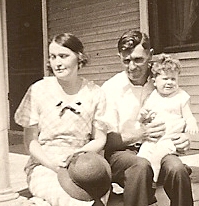
My grandparents had bought the 80-acre farm I grew up on in 1914 when Dad was 16 years old. He lived on that farm on Hwy P, just south of West Bend, the rest of his life.
Click HERE to SUBSCRIBE to
FREE local news at
Washington County Insider on YouTube
Farms were different 100 years ago. The farm fields were small, usually four-to-six-acre plots with different crops in each field. Most 80-acre farms could support about 12-15 cows, which was the common size dairy herd at the time as the cows had to be milked twice a day by hand, morning and night.
In general, milk from the cows was sold in the cities or to small cheese factories. There were many small cheese factories back then, probably 1,000 in Wisconsin alone. Farmers would bring their milk to these cheese factories by horse and wagon to make cheese and butter. That was how dairy farmers existed. Most of the income for farmers in our area came from milk, eggs, and selling some animals, such as pigs, for meat. Dairy was only one part of the farms at that time.
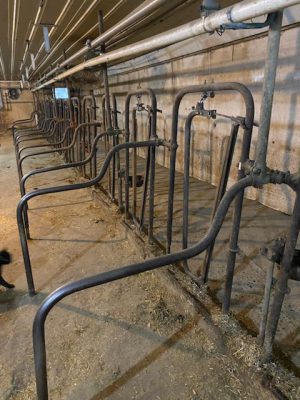
Cows were kept in stanchions in the barn. The stanchions were made of metal and there was a feeding trough in front of each stanchion.
There was also a large metal water tank which held drinking water for the cows. This water tank was suspended tight up against the ceiling of the lower barn, with posts on the floor to support its weight.
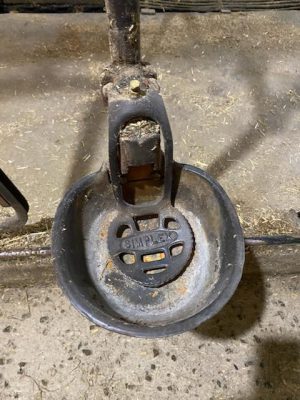
From this water tank, the water flowed by gravity to drinking cups (one cup for two cows). The cows would have to press down on a lever inside the cup with their nose to release fresh water into the cup when they wanted a drink.
In front of the cows, next to the drinking cup, there was a U-shaped trough for hay, silage, or grain feed. The trough was like a big gutter that ran the length of the barn, and the cows would eat from this trough.
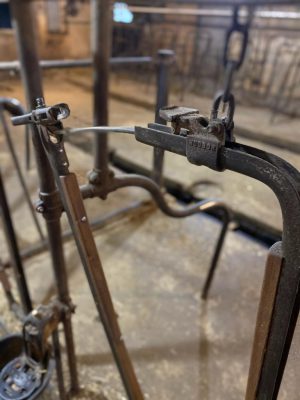
The U-shaped trough would keep the cows’ feed in front of them at all times. The cows would put their head through an opening in their stanchion to reach the feed and water.
The cows were gentle and would have a calf once a year. Before a cow gave birth to a calf, the milk supply was limited from that cow.
After giving birth, the milk supply increased. For a few milkings after a cow gave birth (maybe three or four times), the milk was real dense. We did not sell that milk until the cow’s milk became normal again.

We had about 10 calves each year. The calves would be able to walk 30 minutes after they were born. They would feed on their mother’s milk shortly after birth. When the mother cows would go back to their stanchions, the calves were put in a pen by themselves. The calves would stay in the pen for about three weeks.
Twice a day, we kids would bring the calves to their mothers to nurse from a bag from her belly called an udder. The milk would come from four teats the calves would suck on. Sometimes if the milk didn’t come fast enough for the calf, they would butt their mother’s milk bag with their heads. The mother cow didn’t like this, and she would kick the calf to make them stop.
When the calves finished eating, they would come out from under the mother into the center aisle of the barn which was about 7-8 feet in width. The calves were able to run the day after they were born. They would run in this open aisle as fast as they could, and they did like to run.
It was our job, as kids, to try to catch them. Sometimes when they came to the end of the aisle of the barn, the calves couldn’t stop in time, and they would run into the wall. Then we would quickly catch them and put them back in their pen.
Most of the time, the calves we had were sold for veal. Dad would sell the calves after about three weeks on our farm. But sometimes we would raise a calf. Usually, it was a calf from the best milking cow we had as those calves usually turned into being productive milkers.
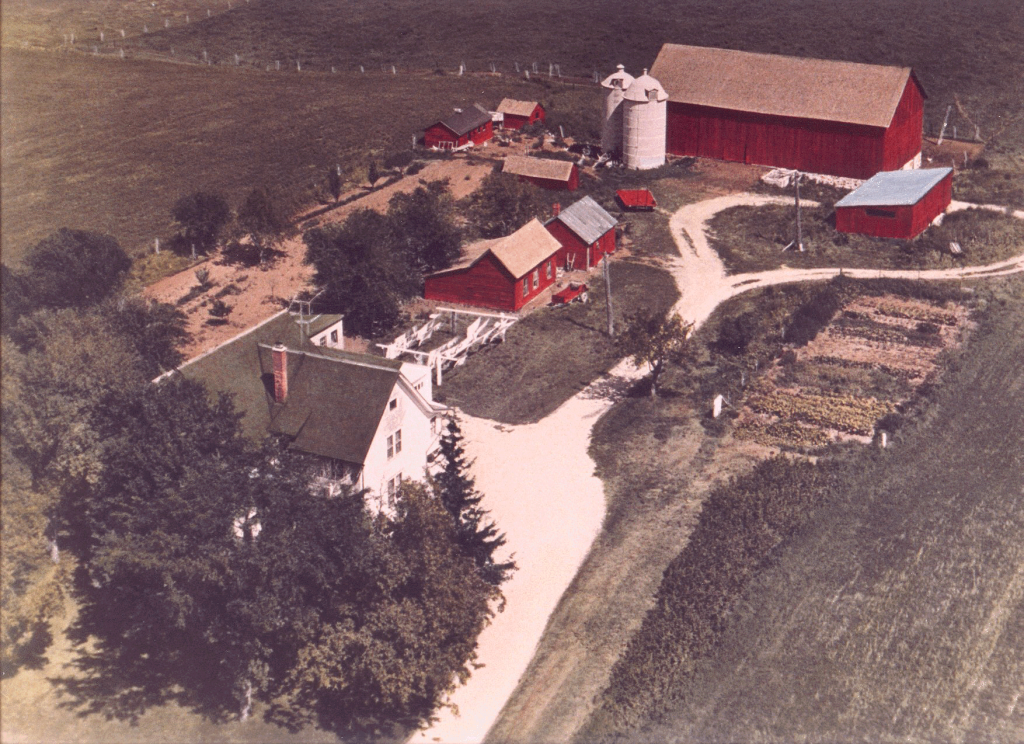
As kids would do, we would make a pet of these calves. We would play with them by bumping our knee against their forehead and they always would butt back with their heads. As small animals, it was fun to have them in a butting match like this. The problem was, they kept playing this game, and when they grew up, they didn’t realize how strong they were. We learned to leave them alone when they got big.
Dad always had about 12 to 15 dairy cows, with each cow giving about 20-30 pounds of milk each day during their prime milking time. This amount would decrease over time. The cows gave different amounts of milk at different times of the year, always giving more milk after having a calf.
The cows were always outside in the pastures at night in the summer. The cows were milked two times a day: in the morning around 7 a.m. and again at 5 p.m. in the afternoon. Most of the time, the cows automatically came back to the barn at milking time. Once in a while, my brother Tom and I would have to go out and get them, but that was very seldom.
Dad and Mom milked the cows sitting on a stool near the cow’s udder. They would massage the bag to allow the milk to move downward. Then they would squeeze the cow’s teats by gently pulling the teats to release the milk. This was hard on your hands until you got used to it by milking a few times. It would usually take about five minutes to milk one cow.
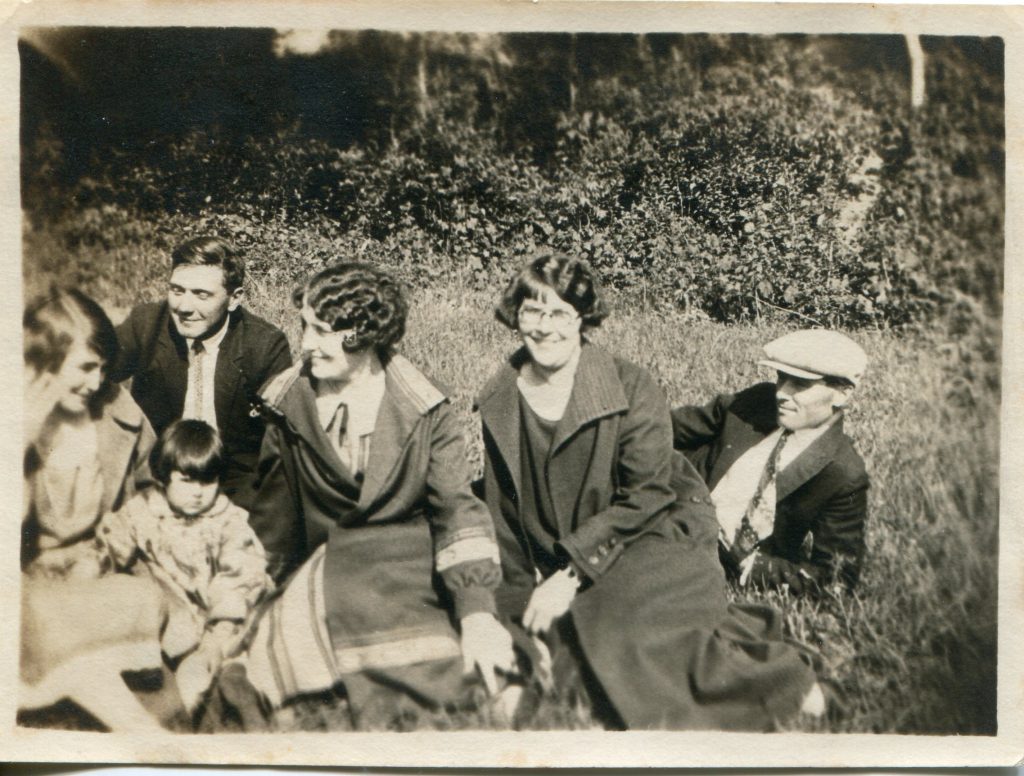
Before my brother Tom and I were old enough to milk by hand, Mom would go to the barn each morning and night to help Dad milk. Mom would put on overalls to help Dad with milking the cows. Otherwise, she always wore a dress. When she got back in the house from milking, she had to take care of us kids. In the morning, she got us up for breakfast and we would dress for school.
Tom and I were probably in 6th and 4th grade when we started to milk. I did help a little with the milking by hand but since I was probably 8-9 years old when I started to help, I can’t say I helped a lot. Tom was older than me, so he did more milking by hand than I did. But Mom and Dad did most of the milking.
We always had kittens in the barn, three or four. When they grew a little bigger, their mother would bring them down from the hayloft to the lower barn where the cows were kept, and they could get fresh milk at milking time. Sometimes the kittens would sit behind the cows and wait for us to squirt milk to them right from the cows. They would sit with their mouths open, and we would squirt the milk and try to get it into their mouths. Sometimes we missed and it would go all over their faces. But they didn’t seem to care.
Before we were old enough to milk, we would play in the lower barn during milking time. Sometimes, our yelling and running around would scare the cows as Dad was milking them and they would kick him. This was the end of our game as Dad was not happy. He would shoo us away to play in the upper barn.
In 1943, we got a milking machine, so milking became a lot easier. Once we had the milk machine, we sometimes still had to strip the cow’s teats to get the rest of the milk out. I don’t know if that was really necessary, but maybe the first milk machines weren’t as good as they are now.
We just had one milk machine. It was electric and the machine was on wheels. It ran in the aisle behind the cows. The milk machine would go from one cow to the next. You hooked a milk can onto the machine and the milk would run through the milk machine directly into the large milk can. That’s how our milk machine worked, but not all of them were like that. When we were done milking, we had to run clean water through the milk machine to clean it.

We usually got about two to four 10-gallon cans of milk each day. After a can was full, we would hoist it into a water tank for cooling. The water in the tank came straight from the well, which was usually 50 degrees. Before we had electricity, the water tank was the only refrigeration we could offer. If the milk wasn’t cooled, the milk would sour, especially in the summer when it was hot outside.
The milk from the evening milking would store in the cooling water tank overnight until the milk man picked it up the next morning. After the milk was picked up, we would drain the cooling water tank and then we would have to refill it with cool well water before the evening milking.
The well was located in a well room next to the barn. There was a door that went between the well room and the barn. A gasoline engine was used to pump water from the well into the large water tank. The well room had a vent to the outside to let the gasoline fumes escape. We did not have electricity until 1936, so we used gasoline to power the pump up to that time.
After we got electricity, the pump was run by electric power. The water tank was made of cement and held five to six old fashioned milk cans. The tank was 3 x 7 feet and was about 3-4 feet high. Even after electricity came to our farm, we continued to use the water tank to cool the milk.
Click HERE to read more local history by Dave Bohn
At one time, Dad and Mom bought three or four cows from my Grandma Thomas that were good milkers. At that time, cows were about $50 a piece. One of the cows they bought gave about 50 pounds of milk per day, so they would have had to pay more for her.
At that time, this cow was considered a real good producer, but she did not like to be milked. She would kick the person milking her and cause a fuss. Because it was all hand milking back then, Dad no doubt had some choice words while milking her. Mom would not milk that cow at all, so Dad would have to milk her twice each day and say what he wanted, although it never helped.

In the winter, our entire drive all the way down to the barn had to be open by 10 a.m. each morning for the milk pickup. My brother Tom and I had the job of shoveling the drive and getting to school by 9 a.m. While we took care of the snow, Dad and Mom would milk the cows and my sister MaryAnn would be in charge of taking care of our younger brother Jerry.
Sometimes, roads were closed by drifting snow. If the milk could not be picked up in a day or so, farmers would use their horse and sleigh to take their milk to the processing plant. When that happened, Dad would load the milk on the sleigh and take it to the factory with his team of horses, Jim and Lucy.
I do remember Dad doing this a few times. He probably had three or four cans of milk that he would load on the sleigh. They were quite heavy, as I think they were 10-gallon milk cans, and would have weighed about 60-70 pounds each. That was when I was pretty little yet, so I never did go along with him.
Because farm work horses were so much bigger, they could easily go through two feet of snow on the roads. Most of the time, the wind would blow the snow in drifts. The road would be passable in most sections. The horses only needed to really work to get through the drifted areas, which was the big problem. But they could. They were big and strong horses.
Our milk usually went to Green Valley Milk Company in Jackson. After the milk was picked up, processed and bottled, it was delivered to households for home use. Some of the milk was sent to factories to make cheese and butter.
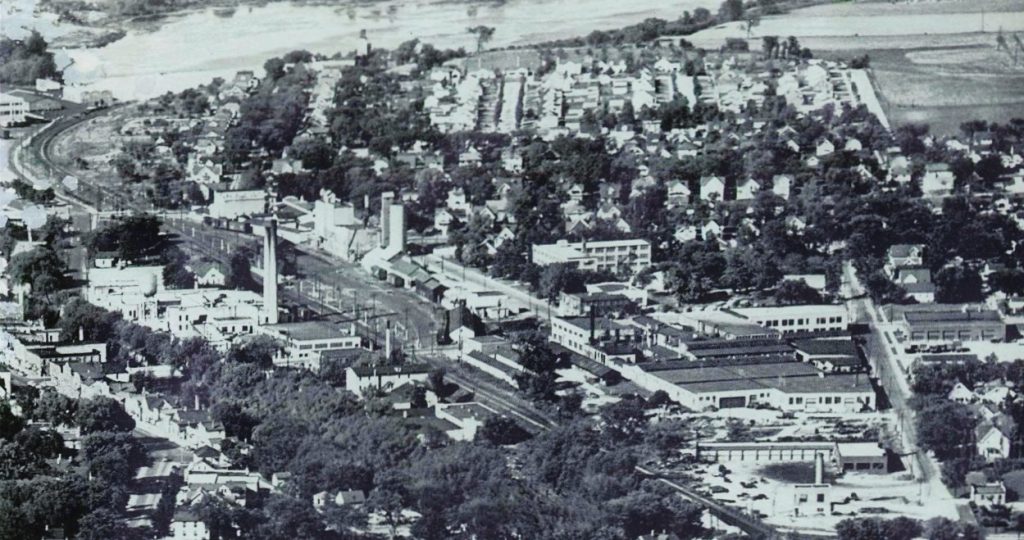
There was also a milk plant for raw milk in the area of the coal yard in West Bend called The White House Milk Company. It was in the vicinity of where the Museum of Wisconsin Art is currently located.
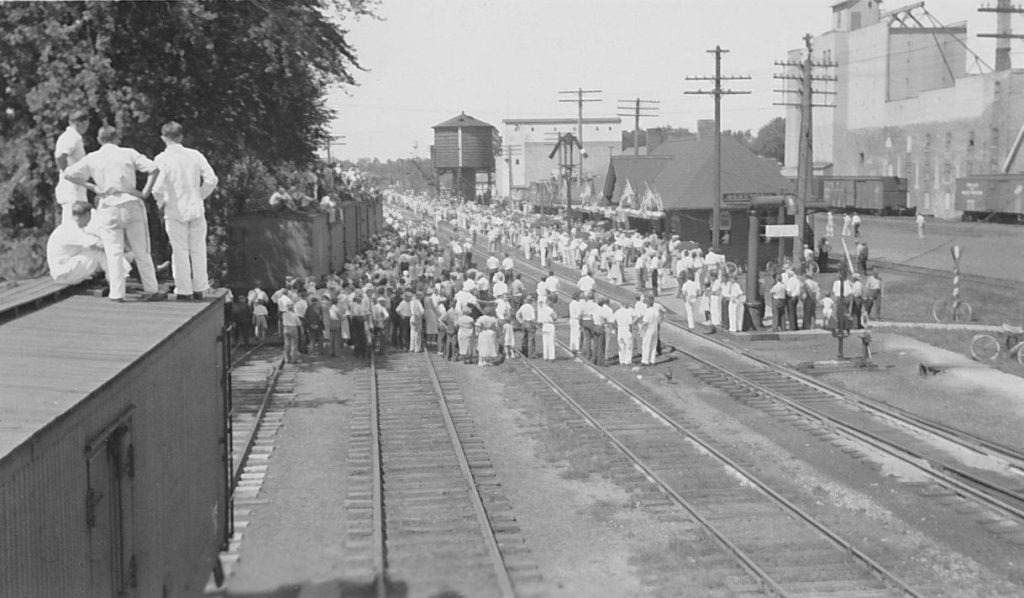
The railroad tracks were right there, and the rail line was the main transportation hub for goods going in and out of West Bend. Milk from the cows on our farm was taken there to be processed for sale at one time. I was pretty little, so I don’t know why Dad changed the milk company. If I had to guess, it was because the prices were better at The White House Milk Company at that time.
There was a tavern nearby where the men from The White House Milk Company would sneak over to for a quick beer. I also remember an old wooden shed near there that was used for storing B & H Lumber’s building materials. When I was older and working for JRV Construction, I remember going to B & H Lumber for shingles and seeing some guys sneak out for a beer.
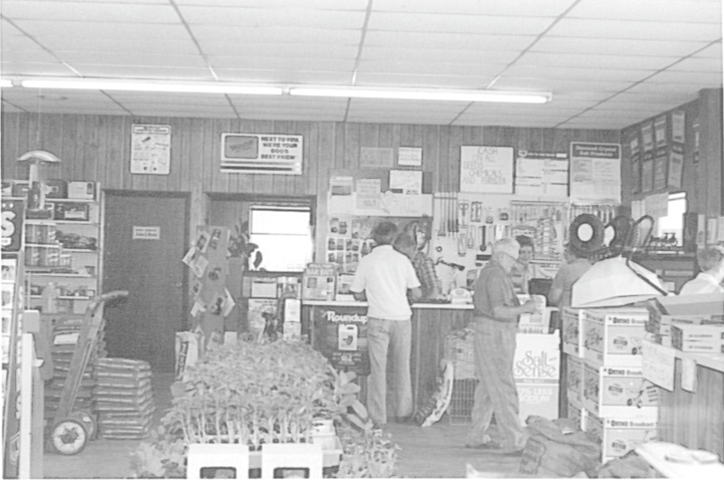
Dad totally gave up dairy farming when my brother Tom went into the service, around 1953. I returned from the service at about that same time. I had been drafted first, as on farms, the oldest son would stay home to help with the farming.
When I returned home, I started working at JRV Construction and Tom was gone, so Dad did not have anyone to help with milking anymore. My younger brother Jerry helped some but he never really got going with farming and Tom and I both started building homes after our time in the service. After Dad stopped the dairy production, he still kept raising chickens for a few more years until eventually he just rented out his land.
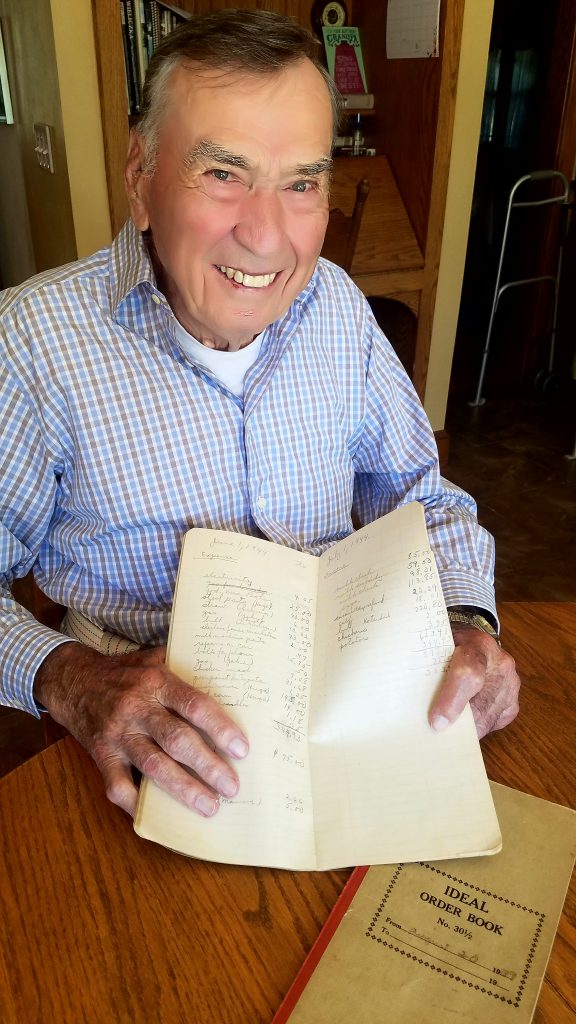
Farms are much larger now than when I was a kid and much more specialized. Dad grew multiple crops to self-sustain the farm and did a little bit of everything to earn a living and feed our family. That’s how it was back then. As for myself, being a farm boy in Washington County was a wonderful way to grow up.




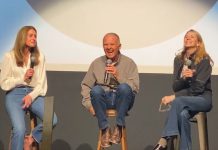


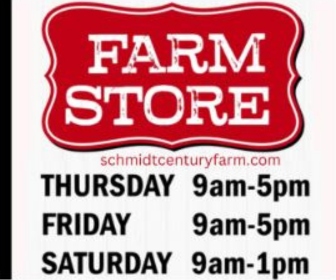





My Family lived across from a Farmer named Berty Bohn in the Town of Erin & helped him milk occasionally. I wonder if he’s related. Back in the 60’s.